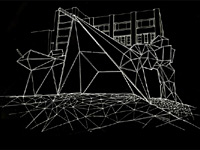Computational Design Theory 3 - CODE2110
Faculty: Built Environment
School: Built Environment
Course Outline: Computational Design
Campus: Sydney
Career: Undergraduate
Units of Credit: 6
EFTSL: 0.12500 (more info)
Indicative Contact Hours per Week: 4
CSS Contribution Charge: 2 (more info)
Tuition Fee: See Tuition Fee Schedule
Further Information: See Class Timetable
View course information for previous years.
Description
In the early nineties, the concept of the paperless studio and the integration of digital media into design practice; the ‘digital turn’, were considered to be merely experiments undertaken by the avant-garde. Today, computation is embedded in all aspects of design practice from conception to construction. New digital design techniques have been joined by new methodologies and formal outcomes. The representation of design has greater sophistication and we understand more about the effects of digital imagery. Computation has also infiltrated the construction of our built environment, from materiality to management. Highly complex information systems process, analyse and integrate components in 3D virtual spaces.
Computation is ubiquitous in our built environment, and its integration has had significant effect on the culture of the design and built environment. The interest we have in technology has moved beyond merely the creation of blob architecture into the new possibilities and challenges it offers to parametrics, sustainability and fabrication. This course will explore the elaborate relationship between computer, the designer and the design and construction of our built environment. The semester’s lectures will help in better understanding the relationships and effect of the continual change and evolution on the social and cultural aspects of our design practices. A range of bridging theories essential to the ‘digital turn’ in building information management, information modelling, as well as the agency for simulation and optimization will be introduced. For example, pre-BIM design concepts; agency in architecture; visualization; materiality and material practice; robotics and making, BIM in practice and so on.
Students will have an opportunity to develop their understanding of ideas and issues through their participation in a critical discussion group. Theoretical understanding will be expanded and formalised through online activities and through illustrated writing exercises, which will be presented in class. The teaching strategy of the course positions students to the concept and theoretical formation of the digital design.









